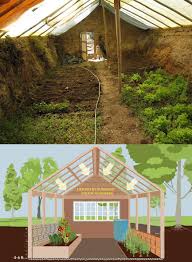Growing plants year-round in cooler or unpredictable climates can be challenging, but an underground greenhouse, also known as a “walipini” or “pit greenhouse,” provides an innovative, sustainable solution. By utilizing the Earth’s natural insulating properties, this type of greenhouse offers a stable environment that protects plants from extreme weather and extends the growing season. Here’s how to build and maintain your underground greenhouse for optimal results.
1. Why Choose an Underground Greenhouse?
Thermal Stability: The Earth acts as an excellent insulator, maintaining a stable temperature a few feet below the surface.
Protection from Harsh Weather: Shielded from wind, snow, and hail, your plants are far less vulnerable to damage.
Extended Growing Season: The consistent environment allows for plant growth even during the coldest months.
Eco-Friendly: With reduced energy requirements for heating, an underground greenhouse is a sustainable and cost-effective option.
2. Selecting the Perfect Location
- Sunlight: Choose a spot with maximum sun exposure. South-facing locations are ideal in the Northern Hemisphere, while north-facing spots work best in the Southern Hemisphere.
- Drainage: Ensure the site has proper drainage to avoid water pooling. Incorporate raised beds or gravel paths to further improve water flow.
- Accessibility: Pick a location that is easy to reach year-round for planting and maintenance.
3. Building Your Underground Greenhouse
a. Excavation
- Depth: Dig 8–10 feet deep for optimal insulation, considering your region’s frost line.
- Size: Standard dimensions might be 10×20 feet, but customize based on your needs.
b. Walls
- Use sturdy materials like bricks, stones, or earthbags for walls, reinforcing them with concrete if necessary.
- Insulate the northern wall with straw bales, foam, or similar materials to retain heat.
c. Roofing
- Install UV-resistant greenhouse plastic, polycarbonate panels, or glass for the roof.
- Design the roof with a slant to maximize sunlight exposure and facilitate rain/snow runoff.
d. Flooring
- A gravel floor aids drainage, though you can also use concrete or leave a natural soil floor, depending on your preference.
e. Ventilation
- Add roof vents or windows near the higher end of the sloped roof for effective airflow.
- Consider installing doors on each end to enhance ventilation and accessibility.

4. Maintaining Your Underground Greenhouse
- Temperature & Humidity: Regularly monitor conditions and use a thermostat if possible.
- Pest Control: Inspect frequently for pests and use natural deterrents to protect your plants.
- Watering: Adjust your watering schedule based on plant needs and humidity levels, taking care to avoid overwatering.
5. Pro Tips for Optimization
- Water Barrels: Place barrels filled with water inside the greenhouse. These absorb heat during the day and release it at night, stabilizing temperatures.
- Raised Beds: Prevent waterlogging and root rot by growing plants in raised beds.
- Reflective Surfaces: Line walls with reflective materials to maximize light distribution throughout the greenhouse.
Conclusion
Building an underground greenhouse is a rewarding endeavor that allows for year-round gardening while reducing environmental impact. Though the initial construction requires effort and investment, the benefits—fresh produce, extended growing seasons, and energy efficiency—make it well worth the effort. With proper planning, maintenance, and care, your underground greenhouse can thrive, providing a consistent and sustainable source of homegrown plants no matter the season.
